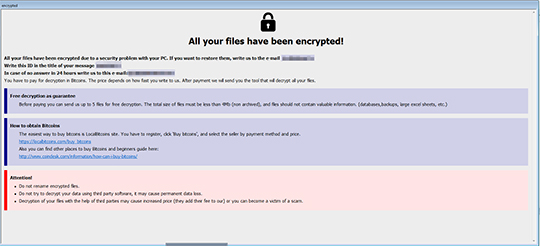Ransom.MSIL.PHOBOS.C
Trojan.Win32.DelShad.dgg (KASPERSKY); MSIL/DelShad.DGG!tr.ransom(FORTINET)
Windows


Threat Type: Ransomware
Destructiveness: No
Encrypted:
In the wild: Yes
OVERVIEW
This Ransomware arrives on a system as a file dropped by other malware or as a file downloaded unknowingly by users when visiting malicious sites.
It drops files as ransom note.
TECHNICAL DETAILS
Arrival Details
This Ransomware arrives on a system as a file dropped by other malware or as a file downloaded unknowingly by users when visiting malicious sites.
Installation
This Ransomware adds the following processes:
- "cmd" /C vssadmin Delete Shadows /All /Quiet
- netsh.exe netsh advfirewall set currentprofile state off
- netsh.exe netsh firewall set opmode mode=disable
- vssadmin Delete Shadows /All /Quiet
- %System%\svchost.exe -k swprv
- %System%\sc.exe start w32time task_started
(Note: %System% is the Windows system folder, where it usually is C:\Windows\System32 on all Windows operating system versions.)
Autostart Technique
This Ransomware drops the following file(s) in the Windows User Startup folder to enable its automatic execution at every system startup:
- %User Startup%\ransom.exe
(Note: %User Startup% is the current user's Startup folder, which is usually C:\Windows\Profiles\{user name}\Start Menu\Programs\Startup on Windows 98 and ME, C:\WINNT\Profiles\{user name}\Start Menu\Programs\Startup on Windows NT, C:\Documents and Settings\{User name}\Start Menu\Programs\Startup on Windows 2003(32-bit), XP and 2000(32-bit), or C:\Users\{user name}\AppData\Roaming\Microsoft\Windows\Start Menu\Programs\Startup on Windows Vista, 7, 8, 8.1, 2008(64-bit), 2012(64-bit), 10(64-bit).)
Other System Modifications
This Ransomware also creates the following registry entry(ies) as part of its installation routine:
HKEY_CURRENT_USER
ransom-782 = {data}
HKEY_LOCAL_MACHINE\SYSTEM\ControlSet001\
services\swprv
Type = 16
HKEY_LOCAL_MACHINE\SYSTEM\CurrentControlSet\
Services\VSS\Diag
SwProvider_{b5946137-7b9f-4925-af80-51abd60b20d5} =
HKEY_LOCAL_MACHINE\SYSTEM\CurrentControlSet\
Services\VSS\Diag
Registry Writer =
HKEY_LOCAL_MACHINE\SYSTEM\CurrentControlSet\
Services\VSS\Diag
COM+ REGDB Writer =
HKEY_LOCAL_MACHINE\SYSTEM\CurrentControlSet\
Services\VSS\Diag
ASR Writer =
HKEY_LOCAL_MACHINE\SYSTEM\CurrentControlSet\
Services\VSS\Diag
Shadow Copy Optimization Writer =
Other Details
This Ransomware adds and runs the following services:
HKEY_LOCAL_MACHINE\SYSTEM\ControlSet001\
services\swprv
HKEY_LOCAL_MACHINE\SYSTEM\CurrentControlSet\
Services\VSS
Ransomware Routine
This Ransomware appends the following extension to the file name of the encrypted files:
- id-{random characters}.[{BLOCKED}s@tuta.io].banks1
It drops the following file(s) as ransom note:
- %User Startup%\info.hta

- {Encrypted directory}\ReadMe.txt

SOLUTION
Step 1
Trend Micro Predictive Machine Learning detects and blocks malware at the first sign of its existence, before it executes on your system. When enabled, your Trend Micro product detects this malware under the following machine learning name:
- Troj.Win32.TRX.XXPE50FFF035
Step 2
Before doing any scans, Windows 7, Windows 8, Windows 8.1, and Windows 10 users must disable System Restore to allow full scanning of their computers.
Step 3
Note that not all files, folders, and registry keys and entries are installed on your computer during this malware's/spyware's/grayware's execution. This may be due to incomplete installation or other operating system conditions. If you do not find the same files/folders/registry information, please proceed to the next step.
Step 4
Restart in Safe Mode
Step 5
Delete this registry key
Important: Editing the Windows Registry incorrectly can lead to irreversible system malfunction. Please do this step only if you know how or you can ask assistance from your system administrator. Else, check this Microsoft article first before modifying your computer's registry.
- In HKEY_CURRENT_USER
- ransom-782 = {data}
- ransom-782 = {data}
- In HKEY_LOCAL_MACHINE\SYSTEM\ControlSet001\services\swprv
- Type = 16
- Type = 16
- In HKEY_LOCAL_MACHINE\SYSTEM\CurrentControlSet\Services\VSS
- Diag
- Diag
Step 6
Search and delete this file
- %User Startup%\ransom.exe
- %User Startup%\info.hta
- {Encrypted directory}\ReadMe.txt
Step 7
Enabling Volume Shadow Service
- Run the command prompt (cmd.exe) as administrator.
- Enable Volume Shadow Service by typing the following command:
net start vss
Step 8
Restart in normal mode and scan your computer with your Trend Micro product for files detected as Ransom.MSIL.PHOBOS.C. If the detected files have already been cleaned, deleted, or quarantined by your Trend Micro product, no further step is required. You may opt to simply delete the quarantined files. Please check this Knowledge Base page for more information.
Step 9
Restore encrypted files from backup.
Did this description help? Tell us how we did.

